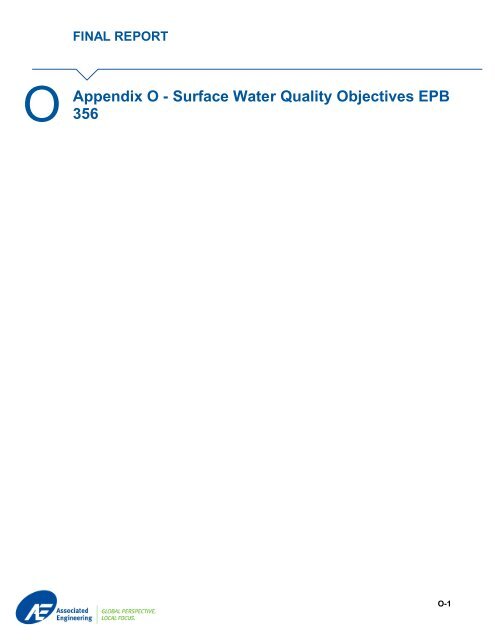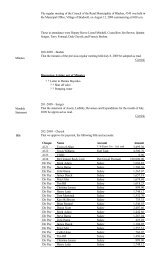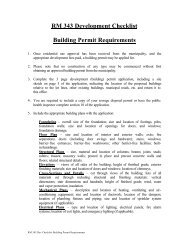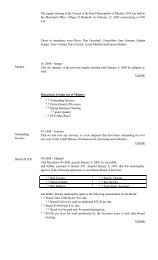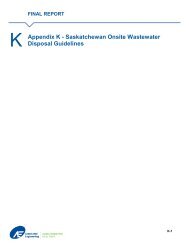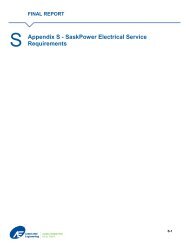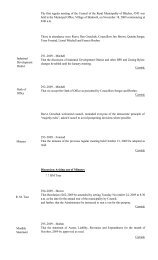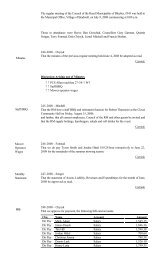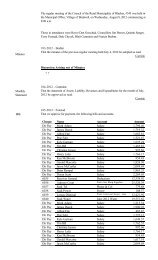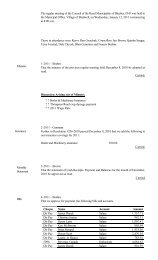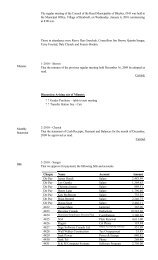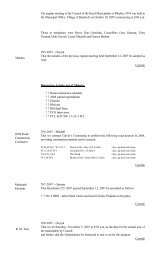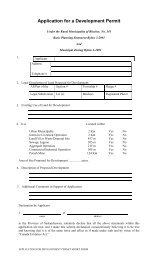EPB 356 - Surface Water Quality Objectives: Interim Edition
EPB 356 - Surface Water Quality Objectives: Interim Edition
EPB 356 - Surface Water Quality Objectives: Interim Edition
Create successful ePaper yourself
Turn your PDF publications into a flip-book with our unique Google optimized e-Paper software.
FINAL REPORTAppendix O - <strong>Surface</strong> <strong>Water</strong> <strong>Quality</strong> <strong>Objectives</strong> <strong>EPB</strong>O <strong>356</strong>O-1
<strong>Surface</strong> <strong>Water</strong> <strong>Quality</strong> <strong>Objectives</strong><strong>Interim</strong> <strong>Edition</strong><strong>EPB</strong> <strong>356</strong>July, 2006
ForewordThe <strong>Surface</strong> <strong>Water</strong> <strong>Quality</strong> <strong>Objectives</strong> (<strong>EPB</strong> <strong>356</strong>, July 2006) were adopted and modified from theCanadian Environmental <strong>Quality</strong> Guidelines (CCME, 1999). Since the CCME is currently revisingtheir protocols for the derivation of water quality guidelines these objectives are now being published asan ‘<strong>Interim</strong> <strong>Edition</strong>’.Any comments, inquiries, or suggestions regarding the content of this document may be directed to:Drinking <strong>Water</strong> <strong>Quality</strong> SectionSaskatchewan Environment3211 Albert StreetREGINA SK S4S 5W6Telephone: (306) 787-6517Fax: (306) 787-0197A copy of this document is available for downloading at the following web address:http://www.se.gov.sk.ca/environment/protection/water/surface.aspTABLE OF CONTENTS1.0 Introduction ...................................................................................................................................... 12.0 Approaches to Guideline Derivation ................................................................................................ 13.0 <strong>Objectives</strong> for Effluent Discharges................................................................................................... 23.1 General <strong>Objectives</strong> ............................................................................................................. 23.2 Guidelines for Effluent Mixing Zones .................................................................................. 34.0 <strong>Surface</strong> <strong>Water</strong> <strong>Quality</strong> <strong>Objectives</strong>.................................................................................................... 44.1 Aquatic Life ......................................................................................................................... 44.2 Agricultural Uses................................................................................................................. 54.3 Recreation and Aesthetics.................................................................................................. 75.0 Saskatchewan <strong>Water</strong> <strong>Quality</strong> Index................................................................................................. 86.0 Potable <strong>Water</strong> Supply ...................................................................................................................... 87.0 Algae and Aquatic Nuisances.......................................................................................................... 98.0 References....................................................................................................................................... 9LIST OF TABLESTable 4.1 <strong>Surface</strong> <strong>Water</strong> <strong>Quality</strong> <strong>Objectives</strong> for the Protection of Aquatic Life .................................. 4Table 4.1.1 <strong>Surface</strong> <strong>Water</strong> <strong>Quality</strong> <strong>Objectives</strong> for Total Ammonia for the Protection of Aquatic Life.... 5Table 4.2 <strong>Surface</strong> <strong>Water</strong> <strong>Quality</strong> <strong>Objectives</strong> for Agricultural Uses ..................................................... 6Table 4.3 <strong>Surface</strong> <strong>Water</strong> <strong>Quality</strong> <strong>Objectives</strong> for Recreation and Aesthetics ...................................... 7
1.0 IntroductionThis document replaces the publication <strong>Surface</strong> <strong>Water</strong> <strong>Quality</strong> <strong>Objectives</strong> (MB #110, August 1997) andits earlier printings and editions.<strong>Water</strong> quality objectives are developed to provide basic scientific information about the effects of waterquality variables on potential water uses such as recreation, agriculture, industrial and municipal watersupplies, and aquatic life. The objectives are important tools which, when used in a framework ofprovincial and federal environmental assessment, risk management, and the application of best availabletreatment technology, support the management, protection and enhancement of the surface waterresources of the province. Those charged with developing objectives (federal, provincial and territorialgovernments, as well as water management agencies such as the Prairie Provinces <strong>Water</strong> Board) mustdecide what uses are to be protected, obtain the necessary information, formulate the objectives, andpresent them for approval to the appropriate jurisdiction. Ongoing, periodic revisions to the surface waterquality objectives are necessary to ensure that new scientific findings are routinely incorporated and thatemerging approaches to enhanced environmental protection are considered. In recent years, much newscientific information has emerged that warrants consideration.<strong>Water</strong> quality objectives have been established for Saskatchewan surface waterbodies as part ofSaskatchewan Environment’s (SE) mandate to manage, enhance and protect this province’s natural andenvironmental resources including air, water and soil. One of the first major steps in the development ofwater quality objectives in this province was the publication of <strong>Water</strong> <strong>Quality</strong> Criteria by theSaskatchewan <strong>Water</strong> Resources Commission in 1970. <strong>Water</strong> <strong>Quality</strong> <strong>Objectives</strong> (1975) was essentiallya reprint of the 1970 document with some minor revisions. The criteria in these early publications werethe main values used to evaluate water quality until 1987, when the Canadian Council of Resource andEnvironment Ministers (CCREM) released the Canadian <strong>Water</strong> <strong>Quality</strong> Guidelines (CCREM, 1987).The Saskatchewan objectives were subsequently revised and updated in 1988 based largely on theinformation provided in the CCREM document and were published as <strong>Surface</strong> <strong>Water</strong> <strong>Quality</strong> <strong>Objectives</strong>(WQ 110 - November 1988). The document <strong>Surface</strong> <strong>Water</strong> <strong>Quality</strong> <strong>Objectives</strong> (MB#110, August 1997)was a reprint of the 1988 booklet and was changed mainly with respect to updating the names,addresses and telephone numbers of agency contacts.In April 1996, the Deputy Minister’s Committee of the Canadian Council of Ministers of the Environment(CCME) gave its approval for the <strong>Water</strong> <strong>Quality</strong> Guidelines Task Group to work towards assembling anintegrated Canadian Environmental <strong>Quality</strong> Guidelines document to be presented to the Ministers.The resulting document was published in 1999 and builds on the highly successful release of theCanadian <strong>Water</strong> <strong>Quality</strong> Guidelines in 1987, which provided national environmental quality guidelinesfor a number of water resource uses. The 1999 publication is the most comprehensive compendium ofits kind in Canada and the world - including a wide range of environmental quality and human healthguidelines for water, soil, sediment, tissue and air - and is the basis for the current version of theSaskatchewan objectives.The <strong>Surface</strong> <strong>Water</strong> <strong>Quality</strong> <strong>Objectives</strong> will be revised on a continual basis in the future as new scientificinformation emerges and as further experience is gained in applying the objectives.2.0 Approaches to Guideline DerivationThe <strong>Surface</strong> <strong>Water</strong> <strong>Quality</strong> <strong>Objectives</strong> are numerical concentrations or narrative statements that haveno legal standing, but instead serve as a guide for issuing permits, licenses and orders, and as a meansof supporting and maintaining designated water uses. While the objectives take into consideration thathealthy aquatic ecosystems can tolerate some stress and can recover, where water bodies areconsidered to be of exceptional value it is a generally accepted policy that degradation of the existingwater quality should always be avoided.1
3.2 Guidelines for Effluent Mixing ZonesA mixing zone is a transitional area within a waterbody in which an effluent discharge is graduallyassimilated into the receiving water. At the outer edge of the mixing zone the water quality should not beappreciably different from the water quality prior to the discharge of the effluent. The size of the mixingzone will be influenced by the difference in water quality between the effluent and the receivingwaterbody and the volume of effluent relative to the receiving waterbody.The effluent mixing zone guidelines are intended for application to larger surface waterbodies. However,they also have limited application to some intermittent streams and small lakes that have sufficient flow orvolume of water, at least seasonally, to adequately assimilate periodic discharges of treated wastewatereffluent.The guidelines should be applied by proponents during the planning and design stages of newdevelopments involving effluent discharge(s) or changes in the flows/volumes of water available foreffluent assimilation, and for current dischargers where alterations of the existing wastewater treatment ordisposal system are proposed. These guidelines prescribe the general characteristics that mixing zonesshould or should not possess.Specific Effluent Mixing Zone Guidelines• the mixing zone should be as small as practicable and should not be of such size or shape as tocause or contribute to the impairment of existing or likely water uses;• the existing General <strong>Objectives</strong> for Effluent Discharges (Section 3.1) should be achieved at all siteswithin the limited use zone;• the limited use zone in streams and rivers should be apportioned no more than 25 percent of thecross-sectional area or volume of flow, nor more than one-third of the river width at any transect inthe receiving water during all flow regimes which equal or exceed the 7Q10 flow for the area.<strong>Surface</strong> water quality objectives applicable to the area must be achieved at all points along atransect at a distance downstream of the effluent outfall to be determined on a case-by-case basis;• in lakes and other surface impoundments, surface water quality objectives applicable to thatwaterbody must be achieved at all points beyond a radius of 100 metres from the effluent outfall. Thevolume of limited use zones in lakes should not exceed 10 percent of that part of the receiving watersavailable for mixing;• the mixing zone should be designed to allow an adequate zone of passage for the movement or driftof all stages of aquatic life; specific portions of a cross-section of flow or volume may be arbitrarilyallocated for this purpose;• mixing zones should not interfere with the migratory routes, natural movements, survival,reproduction, growth, or increase the vulnerability to predation, of any representative aquatic species,or endangered species;• mixing zones should not interfere with fish spawning and nursery areas;• when two or more mixing zones are in close proximity, they should be so defined that a continuouspassageway for aquatic life is available;• when two or more mixing zones overlap the combination of the effluent plumes should not result inunacceptable synergistic or antagonistic effects on aquatic life or other water uses downstream of themixing zone(s);• mixing zones should not cause an irreversible organism response or attract fish or other organismsand thereby increase their exposure period within the zone;• the 96 hr LC 50 toxicity criteria, for indigenous fish species and other important aquatic species shouldnot be exceeded at any point in the mixing zones;• mixing zones should not result in contamination of natural sediments so as to cause or contribute toexcursions of the water quality objectives outside the mixing zone;• mixing zones should not intersect domestic water supply intakes, bathing areas or other sensitivedesignated use areas;• specific numerical water quality objectives may be established by the Department for such variablesor constituents thought to be of significance within the effluent mixing zone; and,3
• defining the effluent mixing zone may need to be done on a case-by-case basis, in consultation withthe Department, particularly where effluent is discharged into smaller waterbodies (i.e. streams andsmall lakes).4.0 <strong>Surface</strong> <strong>Water</strong> <strong>Quality</strong> <strong>Objectives</strong>The specific objectives presented below provide a means for evaluation of water quality conditions exceptin areas of a waterbody in close proximity to wastewater outfalls. In the vicinity of outfalls a "zone ofpassage" of satisfactory quality must be considered for aquatic biota travel. In waters of superior quality,impairment to the objective levels will not be acceptable.4.1 Aquatic Life<strong>Objectives</strong> for protecting the quality of the habitat of aquatic organisms are often more stringent thanthose applicable to other water uses. These objectives (Table 4.1) will afford a reasonable degree ofprotection of fish and other aquatic life at all stages of development. Because of the relatively stringentvalues for various constituents these objectives will also likely afford protection to wildlife, which rely uponsurface water for drinking water and for their source of food supply.Since the release of Canadian <strong>Water</strong> <strong>Quality</strong> Guidelines (CCREM, 1987), it has beenrecognized that water quality objectives for some persistent, bioaccumulative substances such asPCBs, toxaphene and DDT have a high level of scientific uncertainty and limited practicalmanagement value, and are therefore no longer recommended. For these substances, it may bemore appropriate to use the respective tissue residue objectives and/or sediment qualityobjectives.Table 4.1 <strong>Surface</strong> <strong>Water</strong> <strong>Quality</strong> <strong>Objectives</strong> for the Protection of Aquatic Life(modified from CCME 1999)Parameter Objective* CommentsAluminum 5 - 100 See Note 1Ammonia (in mg/L) -- See Table 4.1.1Arsenic 5Bromoxynil 5Cadmium 0.017 – 0.10 See Note 2Chlorine 0.5Chlorpyrifos 0.0035Chromium VI 1Copper 2 - 4 See Note 3Cyanide 5Dicamba 10Diclofop-methyl 6.1Dimethoate 6.2Glyphosate 65Iron 300Lead 1 to 7 See Note 4Lindane 0.01Mercury (inorganic) 0.026Nickel 25 - 150 See Note 5Oxygen, Dissolved (in mg/L) 5.5 - 9.5 See Note 6Pentachlorophenol 0.5Phenols (mono- and dihydric) 4Phenoxy Herbicides (2,4-D) 4Picloram 29Selenium 14
Silver 0.1Temperature Narrative Statement See Note 7Triallate 0.24Trifluralin 0.20Uranium 15 See Note 8Zinc 30*All values in micrograms per litre (ug/L) unless otherwise indicatedNote 1: Aluminum Objective: 5 ug/L at pH 180 mg/LNote 5: Nickel Objective: 25 ug/L where hardness is 0 - 60 mg/L; 65 ug/L where hardness is 60 - 120 mg/L; 110 ug/L wherehardness is 120 - 180 mg/L; 150 ug/L where hardness is >180 mg/L.Note 6: Dissolved Oxygen Objective: 6.0 mg/L for warm-water biota in early life stages; 5.5 mg/L for warm-water biota in other lifestages; 9.5 mg/L for cold-water biota in early life stages; 6.5 mg/L for cold-water biota in other life stages.Note 7: Temperature Objective: Thermal additions should not alter thermal stratification or turnover dates, exceed maximumweekly average temperatures, nor exceed maximum short-term temperatures.Note 8: The objective was developed by the Industrial, Uranium and Hardrock Mining Unit of Saskatchewan Environment.Table 4.1.1 <strong>Surface</strong> <strong>Water</strong> <strong>Quality</strong> <strong>Objectives</strong> for Total Ammonia for the Protection of Aquatic Life*(from CCME 1999)Temp o CPH6.0 6.5 7.0 7.5 8.0 8.5 9.0 9.50 231 73.0 23.1 7.32 2.33 0.749 0.250 0.0425 153 48.3 15.3 4.84 1.54 0.502 0.172 0.03410 102 32.4 10.3 3.26 1.04 0.343 0.121 0.02915 69.7 22.0 6.98 2.22 0.715 0.239 0.089 0.02620 48.0 15.2 4.82 1.54 0.499 0.171 0.067 0.02425 33.5 10.6 3.37 1.08 0.354 0.125 0.053 0.02230 23.7 7.50 2.39 0.767 0.256 0.094 0.043 0.021* in mg/LNote: The toxicity of ammonia relates primarily to the unionized form (NH 3 ). The concentration ofunionized ammonia present in water increases with pH and temperature. The above values representtotal ammonia-nitrogen concentrations (at various temperatures and pH levels) above whichaccompanying NH 3 concentrations may be harmful to aquatic life.4.2 Agricultural Uses<strong>Surface</strong> water quality objectives for agricultural uses are shown in Table 4.2. Users of these objectives,such as resource managers and farmers, are reminded that these values are recommendedconcentration limits of contaminants in irrigation and livestock water; above these limits, possible harm tocrops and livestock may result.As far as irrigation is concerned, the two major factors to be considered when determining water’ssuitability for that use are salinity (measured by electrical conductivity or the concentration of TotalDissolved Solids) and the Sodium Adsorption Ratio or SAR. A plant’s salt sensitivity is a function of manyconditions including type of salt, conditions in the soil, water quality and climate. High SAR levels,meaning excess sodium relative to calcium and magnesium, can negatively impact soil structure bydispersing clay aggregates thus reducing soil permeability and aeration. Since different soils and plantspecies vary considerably in the quality of water each may tolerate, irrigators are advised to contact theIrrigation Development Branch, Saskatchewan Agriculture and Food in Outlook, Saskatchewan5
(telephone 306-867-5528) for guidance regarding site-specific irrigation and cultural practices that wouldbe best suited to the soil types and quality of waters available to them.Livestock, depending upon the species, stage of development, quality of diet and rearing conditions, havedifferent requirements and tolerances to various levels of constituents in waters supplied to them forconsumption. The objectives presented in Table 4.2 are intended to afford protection to most livestockspecies as well as to the consumers of products derived from these livestock.Higher concentrations of constituents addressed in these objectives may be tolerated by some livestockspecies or by adult animals conditioned to such levels. For instance, higher salt concentrations than theobjective level for TDS of 3000 mg/L may be tolerated by some livestock species. In such situationswhere the quality of water available for livestock watering does not meet the objectives livestockproducers are advised to contact their local veterinarian for advice.Table 4.2 <strong>Surface</strong> <strong>Water</strong> <strong>Quality</strong> <strong>Objectives</strong> for Agricultural Uses* (CCME 1999)Parameter Irrigation Livestock CommentAluminum 5000 5000Arsenic 100 25Beryllium 100 100Blue-green algae -- Avoid heavy growthBoron 500 - 6000 5000 See Note 1Bromoxynil 0.33 11Cadmium 5.1 80Chloride (in mg/L) 100 - 700 -- See Note 2Chromium VI 8 50Cobalt 50 1000Coliforms, fecal (E.coli) 100 per 100mL --Coliforms, total 1000 per 100mL --Copper 200 - 1000 500 - 5000 See Note 3Dicamba 0.006 122Diclofop-methyl 0.18 9Fluoride (in mg/L) 1 1 - 2 See Note 4Glyphosate -- 280Iron 5000 --Lead 200 100Lindane -- 4Lithium 2500 --Manganese 200 --Mercury -- 3Molybdenum 10 - 50 500 See Note 5Nickel 200 1000Nitrate + Nitrite (in mg/L) -- 100Phenol -- 2Phenoxy herbicides (2,4--- 100D)Picloram -- 190Selenium 20 - 50 50 See Note 6Sulphate (in mg/L) -- 1000Total Dissolved Solids (in 500 - 3500 3000 See Note 7mg/L)Triallate -- 230Trifluralin -- 45Uranium 10 200Vanadium 100 100Zinc 1000 - 5000 50,000 See Note 8*all values in micrograms per litre (ug/L) unless otherwise indicated.Note1: Boron Objective: 500 ug/L for blackberries; 500 - 1000 ug/L for peaches, cherries, plums, grapes, cowpeas, onions, garlic,sweet potatoes, wheat, barley, sunflowers, mung beans, sesame, lupins, strawberries, Jerusalem artichokes, kidney beans,6
lima beans; 1000 - 2000 ug/L for red peppers, peas, carrots, radishes, potatoes, cucumbers; 2000 - 4000 ug/L for lettuce,cabbage, celery, turnips, Kentucky bluegrass, oats, corn, artichokes, tobacco, mustard, clover, squash, muskmelons; 4000- 6000 ug/L for sorghum, tomatoes, alfalfa, purple vetch, parsley, red beets, sugar beets; 6000 ug/L for asparagus.Note 2: Chloride Objective: 1) Foliar damage: 100 - 178 mg/L for almond apricots, plums; 178 - 355 mg/L for grapes, peppers,potatoes, tomatoes; 355 - 710 mg/L for alfalfa, barley, corn, cucumbers; >710 mg/L for cauliflower, cotton, safflower,sesame, sorghum, sugar beets, sunflowers. 2) Rootstocks: 180 - 600 mg/L for stone fruit (peaches, plums, etc.); 710 - 900mg/L for grapes. 3) Cultivars: 110 - 180 mg/L for strawberries; 230 - 460 mg/L for grapes; 250 mg/L for boysenberries,blackberries, raspberries.Note 3: Copper Objective: 1) Crops: 200 ug/L for cereals; 1000 ug/L tolerant crops. 2) Livestock: 500 ug/L for sheep; 1000 ug/L forcattle; 5000 ug/L for swine and poultry.Note 4: Fluoride Objective: 1.0 mg/L if feed contains fluoride.Note 5: Molybdenum Objective: 50 ug/L for short-term use on acidic soilsNote 6: Selenium Objective: 20 ug/L for continuous use; 50 ug/L for intermittent use.Note 7: Total Dissolved Solids Objective: 500 mg/L for strawberries, raspberries, beans, and carrots; 500- 800 mg/L forboysenberries, currants, blackberries, gooseberries, plums, grapes, apricots, peaches, pears, cherries, apples, onions,parsnips, radishes, peas, pumpkins, lettuce, peppers, muskmelons, sweet potatoes, sweet corn, potatoes, celery, cabbage,kohlrabi, cauliflower, cowpeas, broad beans, flax, sunflowers, corn; 800 - 1500 mg/L for spinach, cantaloupe, cucumbers,tomatoes, squash, Brussels sprouts, broccoli, turnips, smooth brome, alfalfa, big trefoil, beardless wild rye, vetch, timothy,crested wheat grass; 1500 - 2500 mg/L for beets, zucchini, rape, sorghum, oat hay, wheat hay, mountain brome, tallfescue, sweet clover, reed canary grass, birds foot trefoil, perennial ryegrass; 3500 mg/L for asparagus, soybeans,safflower, oats, rye, wheat, sugar beets, barley, barley hay, tall wheat grass.Note 8: Zinc objective: 1000 ug/L when soil pH < 6.5; 5000 ug/L when soil pH > 6.54.3 Recreation and AestheticsRecreational water refers to surface waters that are used primarily for activities in which the user comesinto frequent direct contact with the water, either as part of the activity or incidental to the activity.Examples include swimming, water skiing, bathing and wading. Secondary recreational uses includeboating, fishing and canoeing, which generally have less frequent body contact with water.The objectives shown in Table 4.3 deal mainly with potential health hazards related primarily torecreational water use, but also relate to aesthetics and nuisance conditions. They should affordreasonable protection of water users from waterborne disease and maintain desirable aestheticconditions in the waterbody.Although the use of surface waters for personal drinking water supply is not addressed in this document,recreational water users are cautioned not to consume surface waters without prior disinfection (e.g.boiling, chlorination). Even waters that appear to be pristine may contain naturally occurring diseasecausingmicroorganisms.Table 4.3 <strong>Surface</strong> <strong>Water</strong> <strong>Quality</strong> <strong>Objectives</strong> for Recreation and Aesthetics(modified from CCME 1999)ParameterObjectiveE. coli The geometric mean of at least five samples taken during a period not to exceed30 days should not exceed 2000 E. coli per litre. Resampling should be performedwhen any sample exceeds 4000 E. coli per litre.Blue-green algae Limits have not been specified. Health Canada is in the process of developing anumerical objective for microcystin, an algal toxin. <strong>Water</strong> with blue-green surfacescum should be avoided because of reduced clarity and possible presence oftoxins.Temperature The thermal characteristics of water should not cause an appreciable increase ordecrease in the deep body temperature of bathers and swimmersClarityThe water should be sufficiently clear that a Secchi disc is visible at a minimum of1.2 metres.TurbidityA limit of 50 Nephelometric Turbidity Units (NTU) is suggested.Oil and grease Oil or petrochemicals should not be present in concentrations that:• can be detected as a visible film, sheen, or discoloration on the surface;• can be detected by odour; or• can form deposits on shorelines and bottom deposits that are detectable by sightand odour.7
Aquatic plantsAestheticsBathers should avoid areas with rooted or floating plants; very dense growthscould affect other activities such as boating and fishing.All water should be free from:• materials that will settle to form objectionable deposits;• floating debris, oil, scum, and other matter;• substances producing objectionable colour, odour, taste, or turbidity; and• substances and conditions or combinations thereof in concentrations thatproduce undesirable aquatic life.5.0 Saskatchewan <strong>Water</strong> <strong>Quality</strong> IndexAn integral part of any environmental monitoring program is the reporting of results to both watermanagers and the general public. This poses a particular problem in the case of water quality monitoringbecause of the complexity associated with analyzing a large number of measured variables. Onesolution to this problem is to reduce the multivariate nature of water quality data by employing an indexthat will mathematically combine all water quality measures and provide a general and readily understooddescription of water. An index is a useful tool for describing the state of the water column, and for rankingthe suitability of water for use by humans, livestock, crops, aquatic life, etc.Saskatchewan has adopted its version of the <strong>Water</strong> <strong>Quality</strong> Index (WQI) from the Canadian <strong>Water</strong><strong>Quality</strong> Index (CWQI), recently developed by the CCME <strong>Water</strong> <strong>Quality</strong> Index Technical Subcommittee.In addition to rating the suitability of provincial waterbodies for their potential uses, the Index will be usedin Saskatchewan as a performance measure to gauge progress towards the goal of ensuring thatwatersheds are protected, natural purification and protection processes are maximized, and potential forcontamination is minimized.The WQI formula incorporates three elements: scope – the number of variables that do not meet theSaskatchewan <strong>Surface</strong> <strong>Water</strong> <strong>Quality</strong> <strong>Objectives</strong>; frequency – the number of times these objectivesare not met; and, amplitude – the amount by which the objectives are not met. The WQI produces anumber between 100 (best water quality) and 0 (worst water quality). The resulting Index categories, thatis, Excellent (95 – 100), Good (80 – 94), Fair (65 – 79), Marginal (45 – 64) and Poor (0 – 44), can beused to assess water quality relative to its desirable state and to provide insight into the degree to whichwater quality is affected by human activity.Instructions for calculating the WQI for a specific waterbody are available in the Canadian <strong>Water</strong> <strong>Quality</strong>Index User’s Manual (CCME, 2001).6.0 Potable <strong>Water</strong> SupplyThe maintenance of good quality drinking water can be achieved both by protecting the raw water supplyand by water treatment. It is possible to protect the raw water supply by means of pollution controlmeasures that prevent undesirable constituents from entering the raw water and by good watershedmanagement practices. A wide range of treatment technologies is available by means of which it ispossible to produce acceptable drinking water from most raw water sources.The surface water quality objectives presented in Sections 4.1 to 4.3 above will assist in the protection ofwaters to be withdrawn and treated as a potable supply.Treatment processes for drinking water should be selected to provide potable and aestheticallyacceptable water to the users. For waterworks serving the public, the treated water quality should meetthe current Saskatchewan Municipal Drinking <strong>Water</strong> <strong>Quality</strong> <strong>Objectives</strong>. Untreated water should notbe used for potable purposes.Pharmaceuticals and personal care products in potable water are an emerging concern, however, littledata exists in any country on their presence in treated drinking water. The Department will be working8
with its provincial and federal counterparts to address these issues. Minimizing the impact of thesecompounds depends on proper usage and disposal of the products, proper source water protectionthrough watershed management and provision of proper treatment and distribution systems for drinkingwater supplies.7.0 Algae and Other Aquatic Nuisances"Aquatic nuisances" are those aquatic plants and animals that are present in sufficient numbers to poseproblems for people or animals using a particular waterbody or its surrounding environment. Recreationalwater uses, for example, may be limited by the presence of swimmers' itch, excessive weed growth oralgae blooms. One of the most common aquatic nuisances in Saskatchewan surface waters is algae.Algae are tiny plants, most of which are microscopic in size. Although an important component of aquaticecosystems, certain algae when overabundant can foul beaches and cause water to have an unpleasantcolour, taste or odour. Also high densities of blue-green algae that occurs under bloom conditions insurface waters may result in sickness or death among livestock or pets that drink such water.Various control measures to reduce or eliminate such nuisances as algae, aquatic weeds, leeches,swimmers' itch, and biting insects, are possible. However, aquatic nuisance control activities must becarried out in a manner that will not jeopardize public safety and/or aquatic or terrestrial fauna and flora.Prior to conducting such control activities approval must be obtained from Saskatchewan Environment.The subject of aquatic nuisance identification, control measures, use of chemical/mechanical control, andapproval requirements is described in detail in the publication, A Guide to Aquatic Nuisances and TheirControl (Saskatchewan Environment and Resource Management, reprinted 1998).8.0 ReferencesAlberta Environment, 1999. <strong>Surface</strong> <strong>Water</strong> <strong>Quality</strong> <strong>Objectives</strong> for Use in Alberta. Science andStandards Branch, Edmonton, Alberta. Pub. No.: T/483.Canadian Council of Ministers of the Environment (CCME), 1999. Canadian Environmental <strong>Quality</strong>Guidelines. Ottawa, Canada.Canadian Council of Ministers of the Environment (CCME), 2001. Canadian <strong>Water</strong> <strong>Quality</strong> Index UsersManual. Ottawa, Canada.Canadian Council of Ministers of the Environment (CCME), 2003. Guidance on the Site-SpecificApplication of <strong>Water</strong> <strong>Quality</strong> Guidelines in Canada: Procedure for Deriving Numerical <strong>Water</strong><strong>Quality</strong> <strong>Objectives</strong>, MacDonald Environmental Sciences Ltd.Canadian Council of Resource and Environment Ministers (CCREM), 1987. Canadian <strong>Water</strong> <strong>Quality</strong>Guidelines. Ottawa, Canada.Environment Canada, 1979. <strong>Water</strong> <strong>Quality</strong> Source Book: A Guide to <strong>Water</strong> <strong>Quality</strong> Parameters.Inland <strong>Water</strong>s Directorate, <strong>Water</strong> <strong>Quality</strong> Branch, Ottawa, Canada.Saskatchewan Environment and Resource Management, 1997. <strong>Surface</strong> <strong>Water</strong> <strong>Quality</strong> <strong>Objectives</strong>.Environmental Protection Branch, Regina. MB#110.Saskatchewan Environment, 2002. A Guide to Aquatic Nuisances and Their Control. EnvironmentalProtection Branch, Regina. <strong>EPB</strong> 47.www.SaskH20.ca9


